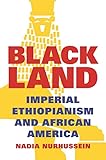Black Land : Imperial Ethiopianism and African America / Nadia Nurhussein.
Material type: TextPublisher: Princeton, NJ : Princeton University Press, [2019]Copyright date: ©2019Description: 1 online resource (280 p.) : 17 b/w illusContent type:
TextPublisher: Princeton, NJ : Princeton University Press, [2019]Copyright date: ©2019Description: 1 online resource (280 p.) : 17 b/w illusContent type: - 9780691190969
- 9780691194134
- African American art -- African influences
- African American art -- 19th century
- African American art -- 20th century
- American literature -- African American authors -- History and criticism
- American literature -- 19th century -- History and criticism
- American literature -- 20th century -- History and criticism
- Ethiopians -- United States
- SOCIAL SCIENCE / Black Studies (Global)
- 810.9896073 23
- PS153.N5
- online - DeGruyter
- Issued also in print.
| Item type | Current library | Call number | URL | Status | Notes | Barcode | |
|---|---|---|---|---|---|---|---|
 eBook
eBook
|
Biblioteca "Angelicum" Pont. Univ. S.Tommaso d'Aquino Nuvola online | online - DeGruyter (Browse shelf(Opens below)) | Online access | Not for loan (Accesso limitato) | Accesso per gli utenti autorizzati / Access for authorized users | (dgr)9780691194134 |
Frontmatter -- Contents -- Illustrations -- Acknowledgments -- Introduction -- Chapter One. Recognizing the Ethiopian Flag -- Chapter Two. Pauline E. Hopkins and the Shadow of Transcription -- Chapter Three. Fashioning the Imperial Self -- Chapter Four. Imperial Embellishment -- Chapter Five. Empire on the World Stage -- Chapter Six. Martial Ethiopianism in Verse -- Chapter Seven. George S. Schuyler and the Appeal of Imperial Ethiopia -- Chapter Eight. Claude McKay and the Display of Aristocracy -- Conclusion. Langston Hughes's business suit -- Notes -- Bibliography -- Index
restricted access online access with authorization star
http://purl.org/coar/access_right/c_16ec
The first book to explore how African American writing and art engaged with visions of Ethiopia during the late nineteenth and early twentieth centuriesAs the only African nation, with the exception of Liberia, to remain independent during the colonization of the continent, Ethiopia has long held significance for and captivated the imaginations of African Americans. In Black Land, Nadia Nurhussein delves into nineteenth- and twentieth-century African American artistic and journalistic depictions of Ethiopia, illuminating the increasing tensions and ironies behind cultural celebrations of a country asserting itself as an imperial power.Nurhussein navigates an assortment of texts by Walt Whitman, Paul Laurence Dunbar, Pauline Hopkins, Harry Dean, Langston Hughes, Claude McKay, George Schuyler, and others, alongside images and performances that show the intersection of African America with Ethiopia during historic political shifts. From a description of a notorious 1920 Star Order of Ethiopia flag-burning demonstration in Chicago to a discussion of the Ethiopian emperor Haile Selassie as Time magazine's Man of the Year for 1935, Nurhussein illuminates the growing complications that modern Ethiopia posed for American writers and activists. American media coverage of the African nation exposed a clear contrast between the Pan-African ideal and the modern reality of Ethiopia as an antidemocratic imperialist state: Did Ethiopia represent the black nation of the future, or one of an inert and static past?Revising current understandings of black transnationalism, Black Land presents a well-rounded exploration of an era when Ethiopia's presence in African American culture was at its height.
Issued also in print.
Mode of access: Internet via World Wide Web.
In English.
Description based on online resource; title from PDF title page (publisher's Web site, viewed 21. Jun 2021)


